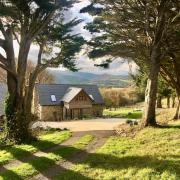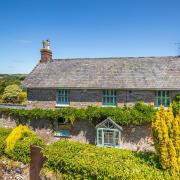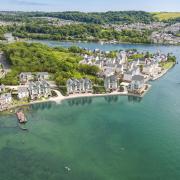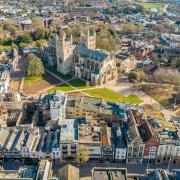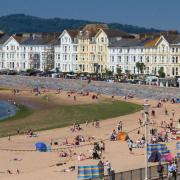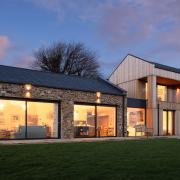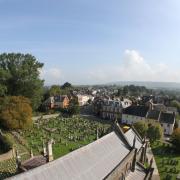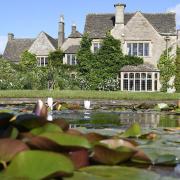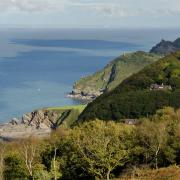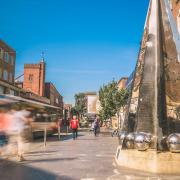Where the Atlantic meets the Bristol Channel off North Devon lies a stunning island jewel, as SARAH HOWELLS discovers

There is a sprinkle of magic in the air as you step onto the jetty at Lundy Island, greeted by the sight of dramatic cliffs tumbling into the turquoise waters. It would be easy to think the sea voyage on the MS Oldenburg had transported you to faraway shores, but this jewel lies just 12 miles off the coast of North Devon.
“There is nothing better than heading to the west of the island with a picnic blanket and a glass of wine and watching the sun go down,” says island manager Derek Green. “It’s unique here in that you can watch the sunrise on one side of the island and sunset on the other – all this often framed by leaping dolphins or basking sharks lolling in the water.”
Given his many roles - as the island’s fireman, coastguard, paramedic, manager, father-figure to the handful of live-in staff and wildlife-watchman - it’s a wonder Derek has any time to enjoy the breathtaking views.

But it was the lure of Lundy which hooked him on a diving trip back in 1989, and in 2004 he moved to the island permanently.
A haven without roads or pollution, and a designated marine conservation zone, Lundy is an idyllic spot for walkers, divers, climbers, bird watchers, model aircraft hobbyists and wildlife enthusiasts alike.
On the west side, exposed to the wild Atlantic, stand high, rugged cliffs. On the east side, sheltered from the prevailing winds, the coastline is gentler with grassy slopes and trees.
“There are no signposts on the island telling you what to do - visitors are largely left to explore at their own pace,” Derek explains. “The village is a world apart. It’s like stepping back in time. You feel completely removed from everyday life.”
Nestled within the quaint, cobbled row of buildings lies the Marisco Tavern, the centre of island life, which never shuts and is the only building to still have light when the generators shut out at night.
With a warm welcome, a ban on mobile phones and stacks of board games, this cosy hub serves a menu of hearty meals including the world-famous Lundy lamb.
“The island is completely self sustainable, and the lamb is reared and butchered in the fields next door,” explains Derek, as he tucks into a meaty, home-made burger with a generous stack of fries.
Around us, visitors chat merrily over pints. “It’s something you don’t see a lot on the mainland – people interacting and talking to each other, rather than poring over their mobiles,” Derek muses.
As the rain subsides to the warm glow of the sun, Lundy takes on a whole new light, the sea sparkling like an azure blanket below the silhouette of the lighthouse – the highest in Britain.
Despite the lack of civilisation on the island, it feels surprisingly alive, teeming with flora and fauna from the unique Lundy cabbage to the shy Sika deer. Scattered across the heathland is a handful of self-catering guest houses, with families and groups of friends dispersing into the distance to enjoy a weekend of solitude away from the bustle of everyday life.
Perched on the cliffside amidst the trees is the grand Millcombe House, the former home of the Heaven family which once owned the island. Still furnished in the décor of its 1836 birth, the house offers the perfect place to perch in a window seat and gaze out over the horizon.
“You can see why, when they took over the island, they chose to build their home here,” says Derek, admiring the view. “You can almost feel the magic here. I love to walk around this part of the island in the winter, when everyone but a couple of the staff have gone back to the mainland.
“It’s so desolate but it doesn’t feel lonely – it’s like the island is alive and you are part of it.”
As the sun fades it’s time to board the MS Oldenburg and return to Ilfracombe harbour – and reality.
But for Derek, as he stands on the jetty, it’s a chance to wave the smiling visitors goodbye, enjoy an evening of laughter with his staff in the tavern, and enjoy the silence of this jewel he calls home. n
Lundy stamps
If you send a postcard from Lundy, you’ll encounter some very special stamps which form part of the oldest private postal service in the world. Lundy stamps were first issued by former island owner Martin Coles Harman in 1929, and since then around 350 different designs have been issued in the Lundy currency of Puffin.
The latest issue celebrates 500 years of Trinity House and its long association with the island. The six stamps, designed by Jan-Erik Wellerfors and Lars Liwendahl, depict scenes such as The Battery, the Old Light building and the Trinity House coat of arms at North Light. Lundy stamps can be ordered by writing to Lundy Postal Service, Lundy, Bristol Channel, Bideford, EX39 2LY.
Wonderful wildlife
Lundy is famed for its thriving puffin population – so much so that the name of the island is believed to come from the old Norse word for ‘puffin island’. Lundy is a haven for birdwatchers, and spring (March to June) and autumn (August to November) are the best times to visit and see the migrating birds. There is also an abundance of other wildlife for those keen to explore the craggy coastlines. Above the waves you’ll find wild ponies, feral goats, pygmy shrews, Sika deer and Soay sheep enjoying the heath and grassland. Below the waves, marvel at sightings of dolphin, porpoise, Lundy’s abundant seal colony and elusive basking sharks. Binoculars are a must for any visit!



